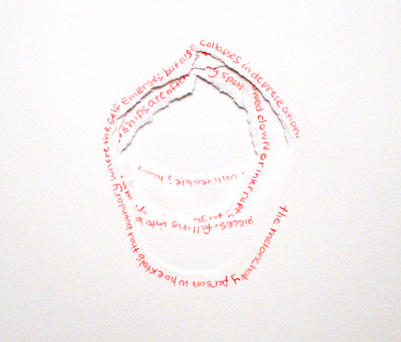
Wound No. 4, 2008
Tina La Porta: Artist | by Andrew Earl Singer, Talent Magazine
The psychiatric condition of featured Artist Tina La Porta and the mind, over what society considers as norm, is the thirst quenching, pill placing link between Artist and Art. Tina is a long term Artist and patient seeking help for her struggles with mental illness. Mental illness has complicated her life from a youth. During a session whereby art was introduced to Tina as a way to explore her creativity and rise to her full potential, along with, other patients seeking relief utilizing art. "I was a practicing artist for a long time before I became so sick, I could not function and needed external help, hospitalization and medications. I will say that while I was in the hospital, art therapy helped me to stay focused on my art and not allow the illness to destroy that part of my life", according to Tina. Tina is very casual, when I interviewed her regarding her psychiatric disorders, she expressed herself eloquently and honestly, despite her emotional distress. Tina says, "while my Doctor was trying to find the best medication to suppress the voices, my artwork became more and more distressed." Working with an art therapist while Tina was in the hospital helped her get in touch with her innermost feelings about her illness.

Wound No. 4, 2008
Tina has created a wide body of museum worthy art, featured in many cultural environments and supported by a large group of followers, collectors and supporters. Artwork has been deemed as one of the best ways for Psychiatric Professional to understand the psychiatric disorders of their patients. Having discussed both her mental illness condition and her art as a decisive way for her to relieve the stress from the war within her own mental struggles. I believe Tina to be a good example to others and wondered if she might share her personal ways to battle the disorder by lecturing to people about her art and the ways she has found to combat those pervasive thoughts. Listening to this very competent person, I realized that she had a greater story to tell and that she needed to start putting her thoughts down and compiling a book as a form of personal introspection for her therapy. A large body of the art work of Tina revolves around mandala's that are made from colored pills. The colored pills suggests that the psychodrama of her life is relieved by medication, medication brings clarification. During her early experience in art therapy, Tina was given the challenge to create an art piece, a mandala. The mandala became a signature art form for her and she has held on to the mandala as an art form. She has gone beyond the mandala to express her art.
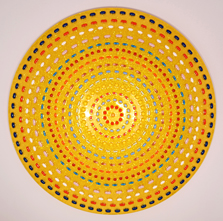
Circles of Obsession, 2014
Tina, describe the other art forms that you have created? Tina says, "I have used my own hands and made casts of them, sculpted them and set pills in the hands. I call the series "Hand to Mouth", the hands are mounted to the walls so it appears as though the hands are offering the pills to the viewer. Prior to that I used plaster bandages to make a sculpture of my hands holding a pile of pills, this was titled "Medicine Ball". I have made a cast sculpture of a face and wrapped the entire sculpture with plaster bandages, suggesting the wounds and suffering I experience. I am making screen prints of photographs of pills and pill bottles that I have been saving for years. In my pill covered resin-based works I am now tinting the resin as a way to visualize how pills dissolve in the body, once consumed."
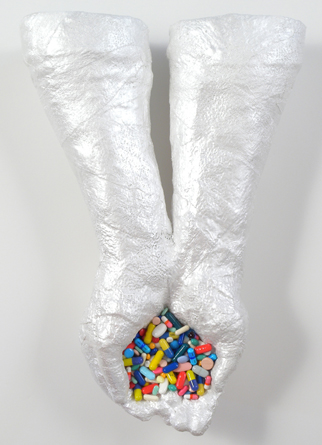
Medicine Ball, 2012
Help me to understand the feelings you have regarding your mental illness and explain how you feel about these situations; isolation, rejection, loss, and alienation. The feature artist states, "I struggle with isolation, it's a struggle for me to engage with others and participate in activities. So, it's very important to me to put my artwork out into the world as a way to make up for my isolation tendencies. Because I tend to isolate myself, I can get left out of events or exhibitions and that tends to fuel my feelings of being rejected. Because of my illness I can't always 'show up and be present', I wish there was more empathy and understanding that this is an everyday struggle for me. Because I had a very difficult and painful childhood and adolescent period, I feel a deep sense of loss, loss of a loving and supportive family unit. I have always longed for support from my family. I deal with feelings of alienation and that ties into my tendency to isolate myself. I don't feel I am understood, or can connect with others. Many people don't understand what it's like to struggle to function on a daily basis." The Staff of Talent Magazine understands exactly what Tina is saying as we are on the front lines in helping people with a host of physical and mental problems that utilize the arts as a way of expression.
Please tell us about how you view your paintings? "I like the uniqueness of the work, the fact that each piece is a portrait of a time in my life, they are markers, what I was going through, my state of mind, the blurring between my illness and my state of mind under a certain medication and how it impacts my work. For instance, medication for schizophrenia can be sedating-- so the work might have that embedded in it, in some way. My art work tells a story-- my story. I would love to see the whole series that I've been developing over the years together in one show. I wonder what kind of impact that might have?", Tina says with excitement.
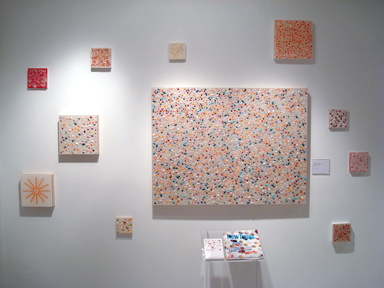
Installation view of Side Effects Series, 2011
"My work is very personal. it comes from my individual experience, however it also has universal impact. Many people after seeing my work, approach me. to tell me their own story of a family member who has had similar struggles. I really enjoy those interactions and that gives me confidence to keep going, because, I am touching a nerve with my audience."
Tina, please recall the efforts you have made in creating your art? Tina replies, "with my resin-based works, I take primarily, over the counter pills and coat each pill with resin. I categorize them based on color, shape and size. I carefully place the pills onto art boards that I've previously painted using a spray gun and automotive paint. I have two different approaches to arranging the pills, one is the mandala format and the other is a disorganized scattered effect. After the pills have been placed, I use another top coat of resin that holds everything together. As far as the sculptures are concerned, I mostly work with mold making and casting techniques. These techniques allow me to extract from the real world, allowing me to make casts of my own hands.
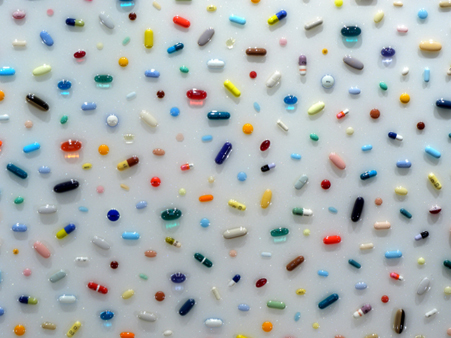
Mirror, Mirror (detail view), 2013
I made a series of sound works where I recalled my experience of hearing voices. I came to terms with the fact that the voices were not real, after hospitalizations, proper diagnosis and medications. I decided to try to recall some of the "conversations" I was hearing. I wrote a lengthy word document, in a stream of consciousness format-- just working from memory. Then, I started to record myself, speaking the words, phrases, and conversations that stuck with me. After that, I began to edit my recordings, trying to stick with certain episodes and themes that came up during that period of auditory hallucinations, delusions and paranoia. After I completed the sound pieces I was able to create an installation at an art venue in Fort Lauderdale, where I built a room out of wood panels. I covered the panels with wallpaper and then hung a series of 'my pill works' on the walls. Behind the walls, out of view, I installed speakers and played back a sequence of all of the sound pieces I previously recorded. I was very happy to be able to re-create what it was like to be in that state of mind where what is real and what is not is completely confused.
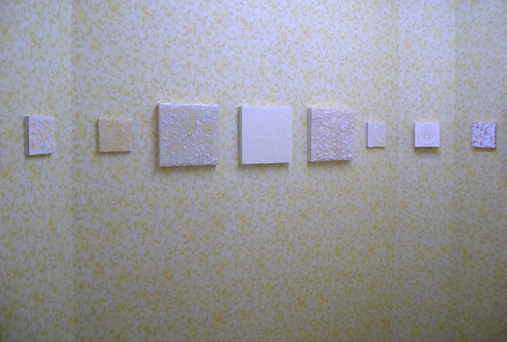
Hearing Voices Installation, 2011